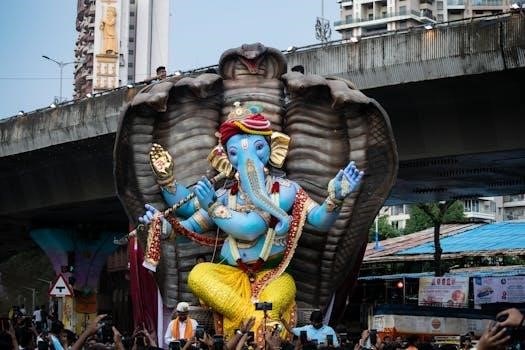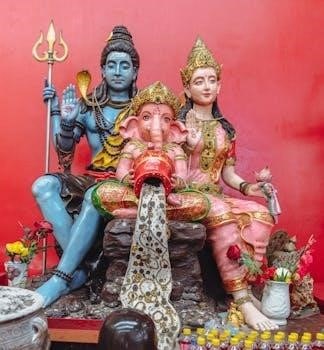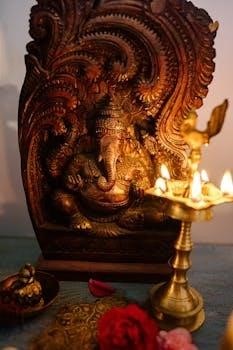Ganesha Ashtothram‚ also known as Ganapathi Ashtothram‚ is a sacred hymn comprising 108 names of Lord Ganesha. Devotees chant these names with reverence to seek divine blessings and overcome obstacles in life. This practice is considered very significant.
What is Ganesha Ashtothram?
Ganesha Ashtothram‚ also referred to as Ganesha Ashtottara Shatanamavali‚ is a compilation of 108 sacred names of Lord Ganesha‚ the widely revered Hindu deity known as the remover of obstacles. Each name in the Ashtothram represents a specific attribute‚ quality‚ or aspect of Lord Ganesha. The term “Ashtottara Shatanamavali” itself translates to “108 names.” This powerful hymn is a prayer of praise and devotion‚ recited by devotees seeking blessings‚ wisdom‚ and success in their endeavors. It is a common practice in Hindu spiritual traditions to chant the Ashtothram as a form of worship.

Significance of Ganesha Ashtothram
Ganesha Ashtothram holds immense significance for devotees. It is a powerful prayer that helps overcome obstacles‚ attain goals‚ and invoke the divine blessings of Lord Ganesha. It is a revered practice.
Lord Ganesha as the Remover of Obstacles
Lord Ganesha is widely revered as the remover of obstacles‚ and this aspect is central to the significance of the Ganesha Ashtothram. Devotees believe that by reciting the 108 names of Ganesha‚ they can overcome challenges and achieve success in their endeavors. Each name in the Ashtothram highlights a specific quality or attribute of Ganesha‚ reinforcing his role as the divine helper who removes hindrances from the path of his followers. Chanting this prayer is seen as a way to invoke his grace and clear any obstacles‚ both internal and external. It is a powerful practice for spiritual progress.
Benefits of Chanting Ganesha Ashtothram
Chanting the Ganesha Ashtothram is believed to bring numerous benefits to devotees. Regular recitation can help individuals overcome obstacles and achieve their goals‚ fostering a sense of peace and well-being. The powerful vibrations of the sacred names are said to purify the mind and body‚ promoting positive energy flow. It is also thought that devotion to Ganesha through this prayer enhances wisdom and spiritual growth. Many seek the blessings of Lord Ganesha for prosperity‚ success‚ and overall happiness in life. It is a powerful tool for connecting with the divine and experiencing its transformative power. The practice is considered highly auspicious.
Ganesha Ashtothram in Telugu
The Ganesha Ashtothram is often recited in Telugu‚ a language widely spoken in India. This practice holds cultural and spiritual importance for many Telugu-speaking devotees. The verses are powerful in this language.
Meaning of Ashtottara Shatanamavali in Telugu
The term “Ashtottara Shatanamavali” translates to 108 names‚ specifically referring to the 108 sacred names of Lord Ganesha. In Telugu‚ this term maintains its profound meaning‚ highlighting the significance of each name in the prayer. These names depict various aspects‚ attributes‚ and forms of the deity. Reciting these names with devotion is considered a path to spiritual enlightenment and the removal of obstacles‚ and it is a deeply respected practice within the Telugu spiritual community. The essence of each name is cherished by Telugu speaking devotees.
Importance of Telugu Language in Recitation
Reciting Ganesha Ashtothram in Telugu holds immense cultural and spiritual significance for Telugu-speaking devotees. The Telugu language‚ with its rich heritage‚ carries a unique vibrational quality that enhances the devotional experience. The phonetic structure of Telugu adds to the rhythmic flow of the chants‚ making the recitation more impactful. The use of Telugu in prayers allows devotees to connect deeply with the divine meanings of the names. This connection fosters a sense of belonging and enhances the spiritual practice‚ bringing the practitioner closer to the divine essence of Lord Ganesha‚ according to ancient traditions.

Ganesha Ashtothram PDF
The Ganesha Ashtothram in Telugu is widely available in PDF format‚ allowing devotees easy access. This digital format is convenient for personal study and recitation‚ fostering devotion to Lord Ganesha.
Availability of Ganesha Ashtothram in Telugu PDF
The Ganesha Ashtothram‚ specifically in Telugu‚ is readily accessible in PDF format across numerous online platforms. This widespread availability caters to the needs of devotees who prefer digital versions for ease of use. Many websites dedicated to Hindu scriptures and devotional content offer free downloads of this sacred text. This makes it convenient for individuals to incorporate the Ashtothram into their daily spiritual practice. The PDF format also allows users to easily print or save the text‚ ensuring its accessibility for personal use without any cost. These resources can be found on both religious and general information websites‚ making this version of the Ashtothram easily attainable.
How to Download the PDF
Downloading the Ganesha Ashtothram in Telugu PDF is a straightforward process. Begin by searching for reputable websites that offer religious texts. Look for links specifically labeled “Ganesha Ashtothram in Telugu PDF;” Upon finding a suitable link‚ simply click on it to initiate the download. The file will usually be saved in your device’s downloads folder. Ensure that the website is secure to avoid any potential malware. After the download is complete‚ you can access the PDF from your device for reading‚ printing‚ or saving as needed. This easy method allows quick access to this revered spiritual text for personal use and devotion.
Structure and Content
The Ganesha Ashtothram is structured around 108 names of Lord Ganesha. Each name signifies a unique aspect or quality of the deity. These names are traditionally chanted in a specific order.
The 108 Names of Lord Ganesha
The Ganesha Ashtothram‚ also referred to as Ashtottara Shatanamavali‚ consists of 108 unique names of Lord Ganesha. Each name is a powerful mantra‚ reflecting a specific attribute‚ form‚ or divine quality of the deity. These names are traditionally recited as a form of worship‚ invoking the blessings of Ganesha‚ the remover of obstacles. These names often highlight his wisdom‚ strength‚ compassion‚ and his role as a guide for spiritual seekers. The sequence of names in the Ashtothram is a carefully constructed arrangement‚ meant to resonate with devotees and deepen their connection with Ganesha. Reciting these names is a potent spiritual practice.
Understanding the Deeper Meanings of the Names
Each of the 108 names within the Ganesha Ashtothram carries a profound symbolic meaning‚ representing a facet of Lord Ganesha’s divine nature. These names are not mere labels; they are powerful mantras encapsulating Ganesha’s wisdom‚ strength‚ compassion‚ and his various roles in the cosmic order. Contemplating the meanings of names like ‘Vighnaharta’ (remover of obstacles) or ‘Ekadanta’ (single-tusked) allows devotees to connect with Ganesha on a deeper level; This understanding enhances the spiritual practice‚ transforming simple recitation into a journey of self-discovery and devotion. Delving into these meanings enriches the experience and fosters a stronger bond with the deity.

How to Use Ganesha Ashtothram PDF
The Ganesha Ashtothram PDF serves as a valuable tool for spiritual practice. It can be integrated into daily routines for chanting‚ aiding devotion and fostering a deeper connection with Lord Ganesha.
Integrating into Daily Spiritual Practice
Incorporating the Ganesha Ashtothram PDF into your daily spiritual practice can be a transformative experience. Begin by setting aside a specific time each day‚ preferably in the morning or evening‚ for the recitation. Find a quiet and peaceful place where you can focus without distractions. Using the PDF‚ carefully read each of the 108 names of Lord Ganesha‚ either aloud or silently‚ with deep concentration and devotion. This practice can help cultivate mindfulness‚ reduce stress‚ and foster a closer relationship with the deity. Consistency is key‚ so try to make it a regular part of your daily routine. The repetitive nature of chanting the names is a method for calming the mind and entering a meditative state.
Correct Pronunciation and Chanting
Accurate pronunciation is vital when chanting the Ganesha Ashtothram‚ especially in Telugu. The sounds and intonations carry deep spiritual significance. If you are unfamiliar with the Telugu language‚ seek guidance from a knowledgeable teacher or use audio resources to learn the correct way to pronounce each name. Pay close attention to the stress‚ rhythm‚ and flow of the words. Chanting with proper pronunciation enhances the efficacy of the practice and deepens your connection with Lord Ganesha. Try to maintain a steady and focused pace‚ avoiding rushing through the names. This will help you to connect with the spiritual energy of the mantra and cultivate inner peace.

Additional Resources
For further exploration‚ numerous websites and spiritual centers provide information on Ganesha Ashtothram. You can find audio recordings‚ translations‚ and related texts to deepen your understanding and practice.
Where to Find More Information
Numerous online resources offer detailed information about Ganesha Ashtothram‚ including its significance‚ the meaning of each name‚ and guidance on chanting. Websites dedicated to Hindu scriptures and spirituality often provide comprehensive articles and downloadable PDFs of the Ashtothram in various languages‚ including Telugu. Additionally‚ many YouTube channels feature recitations and explanations of the prayer. Devotional forums and communities online can also be valuable sources for insights and support in your spiritual practice. Look for reputable sources like Vaidika Vignanam and Stotranidhi for authentic content and accurate translations.
Other Related Texts and Prayers
Besides the Ganesha Ashtothram‚ several other texts and prayers are dedicated to Lord Ganesha. These include the Ganesha Chalisa‚ a forty-verse hymn; the Ganesha Aarti‚ a devotional song; and various stotras and mantras praising different aspects of the deity. Many devotees also recite the Vakratunda Mahakaya mantra. Exploring these related texts can deepen your understanding of Lord Ganesha and enhance your spiritual journey. Look for these resources in Telugu and other languages to broaden your knowledge of Hindu devotional literature. These texts often complement the Ashtothram and provide a more holistic view of Ganesha.